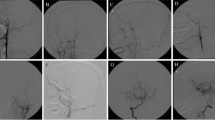Summary
Encephalo-duro-arterio-synangiosis (EDAS) is a new surgical operation for childhood moyamoya disease, and its effects have been studied by comparing pre-and postoperative angiograms in 27 patients. The development of collaterals from the external carotid arterial system into the territory of the middle cerebral artery was excellent in 16 of 54 cerebral hemispheres after EDAS, good in 25, and poor in 13. The development of collaterals after EDAS increased as the stenotic process in the internal carotid artery on preoperative angiograms increased except in the most advanced cases, where it seemed to decrease in comparison with the group with middle grade stenosis. After EDAS, not only the superficial temporal artery, but also the adjacent middle meningeal artery participated in forming collateral pathways. Furthermore, decrease of abnormal net-like vessels was observed when there was good to excellent development of collateral vessels. Stenotic lesions in the internal carotid and posterior cerebral arteries were often seen to progress, indicative of the rapidly progressive nature of childhood moyamoya disease. These results appear to suggest that EDAS should be performed as early as possible in childhood moyamoya disease before the occurrence of an irreversible ischaemic state and/or permanent neurological defects.
Similar content being viewed by others
References
Kudo T (1968) Spontaneous occlusion of the circle of Willis. Neurology 18: 485–496
Nishimoto A, Takeuchi S (1968) Abnormal cerebrovascular network related to the internal carotid arteries. J Neurosurg 29: 255–260
Suzuki J, Kodama N (1983) Moyamoya disease-a review. Stroke 14: 104–109
Taveras JM (1969) Multiple progressive intracranial arterial occlusions: a syndrome of children and young adults. Am J Roentgenol 106: 235–268
Pecker J, Simon J, Guy G, Herry JF (1973) Nishimoto's disease: significance of its angiographic appearances. Neuroradiology 5: 223–230
Handa J, Handa H (1972) Progressive cerebral arterial occlusive disease: analysis of 27 cases. Neuroradiology 3: 119–133
Takahashi M (1980) Magnification angiography in moyamoya disease: new observations on collateral vessels. Radiology 136: 379–386
Hasuo K, Tamura S, Kudo S, Uchino A, Carlos R, Matsushima T, Kurokawa T, Kitamura K, Matsuura K (1985) Moyamoya disease: use of digital subtraction angiography in its diagnosis. Radiology 157: 107–111
Amine AR, Moody RA, Meeks W (1977) Bilateral middle cerebral artery anastomosis for moyamoya syndrome. Surg Neurol 8: 3–6
Karasawa J, Kikuchi H, Furuse S, Kawamura J, Sakaki T (1978) Treatment of moyamoya disease with STA-MCA anastomosis. J Neurosurg 49: 679–688
Karasawa J, Kikuchi H, Furuse S, Sasaki T, Yoshida Y, Ohnishi H, Taki W (1977) A surgical treatment of “moyamoya” disease. “Encephalo-myo-synangiosis”. Neurol Med Chir (Tokyo) 17: 29–37
Karasawa J, Kikuchi H, Kawamura J Sakaki T (1980) Intracranial transplantation of the omentum for crebrovascular moyamoya disease: two-year follow-up study. Surg Neurol 14: 444–449
Matsushima Y, Fukai N, Tanaka K, Tsuruoka S, Inaba Y, Aoyagi M, Ohno K (1981) A new surgical treatment of moyamoya disease in children: a preliminary report. Surg Neurol 15: 313–320
Matsushima Y, Inaba Y (1986) The specificity of the collaterals to the brain through the study and surgical treatment of moyamoya disease. Stroke 17: 117–122
Satoh S, Shibuya H, Matsushima Y, Suzuki S (1988) Analysis of the angiographic findings in cases of childhood moyamoya disease. Neuroradiology 30: 111–119
Ausman JI, Moore J, Chou SN (1976) Spontaneous cerebral revascularization in a patient with STA-MCA anastomosis. J Neurosurg 44: 84–87
takeuchi S, Tsuchida T, Kobayashi K, Fukuda M, Ishii R, Tanaka R, Ito J (1983) Treatment of moyamoya disease by temporal muscle graft “encephalo-myo-synangiosis”. Child's Brain 10: 1–15
Miyamoto S, Kikuchi H, Karasawa J, Nagata I, Ikota T, Takeuchi S (1984) Study of the posterior circulation in moyamoya disease. Clinical and neuroradiological evaluation. J Neurosurg 61: 1032–1037
Miyamoto S, Kikuchi H, Karasawa J, Nagata I, Ihara I, Yamagata S (1986) Study of the posterior circulation in moyamoya disease, part 2. Visual disturbances and surgical treatment. J Neurosurg 65: 454–460
Author information
Authors and Affiliations
Rights and permissions
About this article
Cite this article
Yamada, I., Matsushima, Y. & Suzuki, S. Childhood moyamoya disease before and after encephalo-duro-arterio-synangiosis: an angiographic study. Neuroradiology 34, 318–322 (1992). https://doi.org/10.1007/BF00588191
Received:
Issue Date:
DOI: https://doi.org/10.1007/BF00588191




